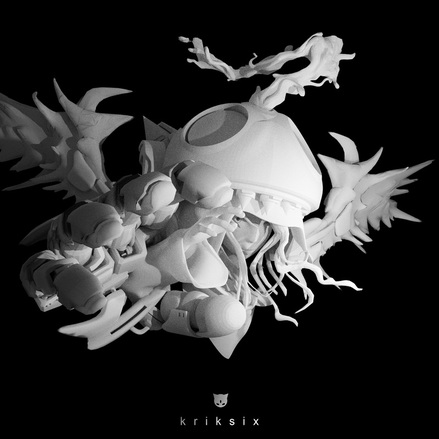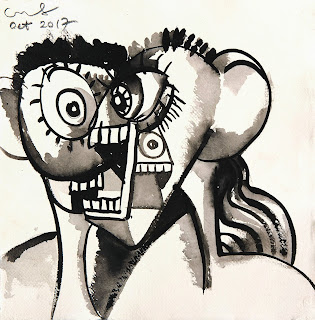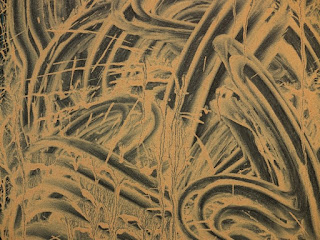Wax print: 1987
More recently I had to learn 123D Catch, a 3D wireframe modelling software. This was software that allows you to take photographs of an object from as many different positions as possible and then load them up to a cloud; they were then processed in order to make a wireframe 3D model of what you had made. I tried it with a pig model I had done as part of something else and then played with the image to see how it could be manipulated. Once you had completed the editing phase you could then export the information into 123D Make, a program that was linked to 3D printer outputs. All now obsolete as 123D Catch has gone the way of many programs before it.
I did use some of the wire frame drawings I made of fires to make prints, but I never really got to grips with the technology.
Screenprint: 2014
However I have recently returned to thinking about how 3D printing can be used to extend my ideas. This time I'm more interested in the decision making processes involved and as someone always worried about things, I have begun to reflect on whether or not computers will eventually be able to take over creativity from us and that consciousness, that quality that all creative people love to cite as being central to their work, is perhaps over valued.
I came across an interesting way of thinking about 3D printing a couple of years ago at a drawing conference and this rekindled my interest and made me think about the potential of working in this area again. Corneel Cannearts was working with what he termed 'allographic machines'. He had adopted a Nelson Goodman term, ‘allographic drawing’ as a way to think about drawing and its relationship to drawing technologies, citing the first drawing as being done by tracing around the edge of a shadow. It was however when he introduced the term 'encoded matter', that I became very interested in the process. I have often used the term 'material thinking' when talking about drawing and his concept of 'encoded matter' felt very close to what I was thinking about. (You can find my original notes on Cannearts presentation here)
The creating of 3D forms digitally is totally different from making objects directly by using physical interaction with a material. However I have been making quite a lot of ceramics lately and at the same time I have been thinking more and more about the role of human beings in relation to the bigger picture of how things interact. (See my posts linked to object orientated ontology) A few months ago I wrote this, "What Object Orientated Ontology is proposing to do is to help us to step outside of our human centred framework and to consider how things might be if everything was simply about 'objects'. For example, the 'life' of a stone is a life that inhabits its own timeframe, a timeframe that we as humans would not be able to understand or perceive, our lives in comparison to a stone's existence being as short as a mayfly". I was thinking more and more about how creativity can be seen as 'things coming together', not just about something that only humans can do.
Back in the studio this morning, I'm making drawings using water based paints and inks. As the grains of material flowed over the now buckling paper, pools of liquid kept forming and previously drawn on surfaces were emerging and disappearing as these pools developed, all mainly out of my control. It was a sort of dance, whereby I needed to learn to move and flow with the materials and their own inclinations. In effect my contribution is just one part of a process that also includes what water does, what paper does and what pigments do. When I make ceramics I'm very aware that my fingers are very limited as to what they can do, arthritis prevents any fine control, so I have learnt to follow what the clay needs to do. So how does this way of thinking work when using 3D software?
The first time I used the technology I very quickly became interested in how the hollow shells could be manipulated, and in the image of a divided pig above, you can see that the surface that the pig was on when I took the initial photographs has become an integral part of the new image. What interested me at the time was that the camera could not differentiate between one thing and another, a fact that seemed to ask questions of our word orientated world view. We separate the ground from the object because we have separate words for them, but what if there were no defining words? The technology was in some ways 'thinking' without my intervention.
This time I felt more prepared for these issues and wanted to be able to control or at least set up an illusion of control within the situation.
I began the process with a drawing, I have made several of these images of people wrestling, their heads merging together as they feel out each other's body, ready to throw as soon as they find a weakness in the other person's stance. I'm always searching for images that I can use as allegories and this was one I felt was getting somewhere. I was thinking that in opposition we become more and more like the person we oppose. So the next stage was to make these images in clay.
The figures became more merged as I made them, arms belonging to both figures and I thought these were a better resolution to the problem than the initial drawings. It was at this stage that the possibility of going on to use 3D printing presented itself. I had been fascinated by the way that clay's 'clumpiness' sort of controlled what was coming out and I was interested in how when you fire things, you have to let go and see what happens. The surfaces were finally resolved by applying two different types of wax with soft cloths, again something I hadn't predicted, but which came about as a result of me trying things out.
So how could I use the computer technology and still allow for the material to think for itself?
The first stage is imaging and I was using a special camera that had 4 sensitive lenses.
The ceramic was placed on a turntable and the camera on a tripod. (You don't need to do this in order to get 3D information, you could simply move the camera around the object and take images but I felt this too random). What was interesting was that you could set the object up to be scanned in such a way that part of it was always hidden, or in shadow as far as the 3D camera was concerned. I.e. you can control how much information to give the software to work with. Gradually as the image is rotated the 3D skin is built up and you see it emerge on screen.
Sometimes the missing areas are due to reflection but the more the object is rotated the more information gaps are filled. However a 3D printer abhors a vacuum and when there is a hole, as can be seen emerging in the image above between the neck/head and the arm, the software will deduce that something is needed to fill the gap. The blue image below, shows what happens when the software begins to render the image for 3D printing, it somehow deduces what to do by responding to surrounding surface details and fills in the gap with its own 'invention'.
When you come to set the image up for 3D printing there are a series of options that allow you to engage with the areas of missing information. One area you can manipulate is the orientation of the image in relation to the base plate. Once set, (and this is always necessary because the x, y, z axis as set on the camera is not the same as on the printer), you can ask the computer to add supporting structures to any areas that would in effect be floating and these are the columns that are holding the structure up. The strange rounded 'feet' are the result of the camera not having the bottom of the legs on one side of the ceramic in the frame when images were taken. The computer software has 'guessed' what these would be like. This combination of actual readings, the computer guessing how to resolve areas it didn't have any information for and the fact that it needed to invent structures to hold up 'floating' forms, finally resulted in the images below.
I am now beginning a second set of models, whereby I'm trying to increase the sense of scale that the supporting structures provide. Can I trigger a reading that is even more like a 'monster attacking a city'?
The process has moved the idea on quite a long way. I'm fascinated by the way that the more you let go of a process the more it seems to run in directions that make much more sense than if you were in control. In particular in this case it has taken me right back to films I saw as a boy in the 1950s and 60s. They must still haunt my imagination.
Model of the monster in the film, 'The Angry Red Planet'
Rodan from the Godzilla films
Both these films rely on model making and filming the models from a low angle so that they appear much larger then they really are. I have done exactly the same with the 3D printed model, an aspect of 3D drawing and thinking that I put up a post on a couple of years ago; 'when making models to work from'.
One of the most interesting contemporary artist working with 3D printing technology is Nate Boyce.
Nate Boyce
Boyce is interested in the illusion of space as emerging from the history of painting and at the same time is a sculptor interested in how form occupies mass within space. In the middle ground is 3D printing, a process relying entirely on a drawing convention that emerged from the Renaissance.
Sumit Sarker
Sumit Sarker also works under the name Kriksix. He is based in Manchester and is working to combine marble sculpture with 3D printing, alongside augmented reality and projection mapping. He is looking to create totally immersive audio/visual/sculptural experiences, and is able to perfectly fit together stone, plastic, wood and metal because of the holistic digital nature of the shaping process. The video below shows how drawing is again central to the thinking process he goes through and it reinforces my own understanding of how drawing is central to all 3D digital thinking.
Sumit Sarker: The evolution of a sculptural idea
See also:

























































